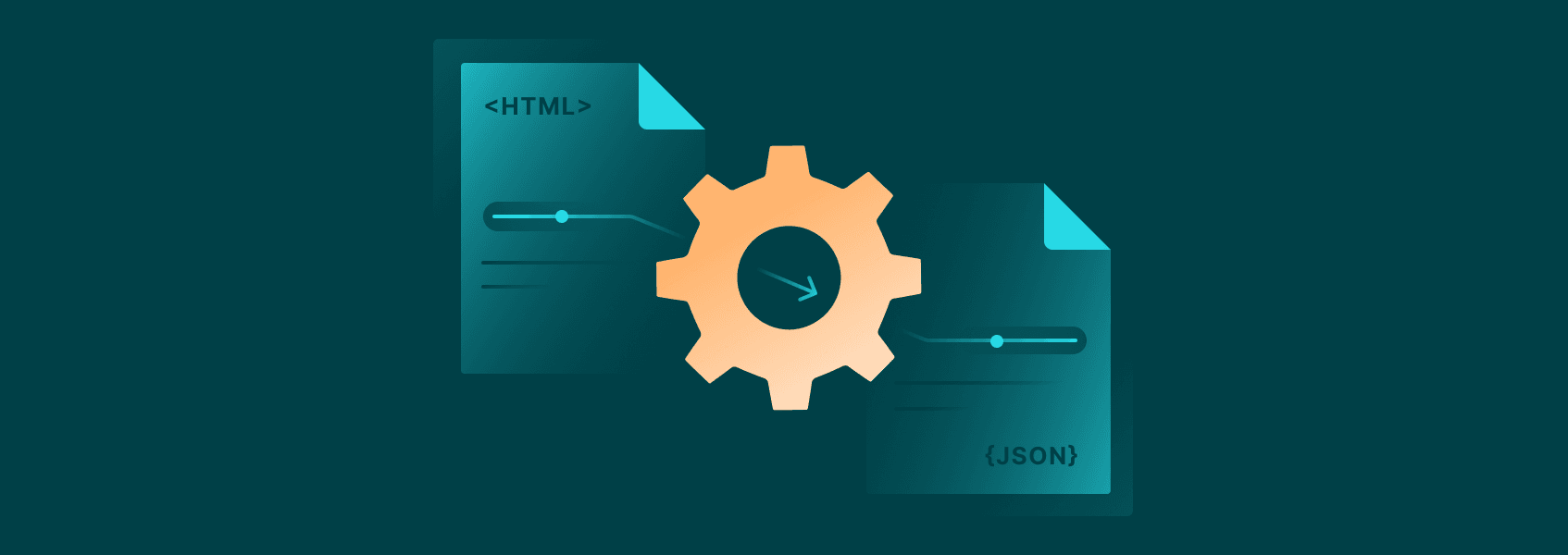What Is Data Parsing?
Tutorials

Justas Palekas
Data parsing is the process of converting raw, unstructured data, such as text files or website data, into a structured and more usable format. As a result, the data is easier to store, process, and analyze. The process often includes a conversion from one format to another, such as from text to CSV or JSON.
This process is widely used in web scraping projects where most of the data is received in various unstructured formats, which are difficult to analyze.
End-goal file formats for parsed data depend heavily on the analytical infrastructure used by a company or organization. Common formats, however, are JSON, CSV, XLSX, SQL, and many others.
How Does Data Parsing Work?
Data parsing is performed by a dedicated solution, usually called a data parser. There are four stages to data parsing and, as such, to a data parser:
1. Input file
All data parsing begins with some input file that holds data in a format that’s hard to analyze, import to a database, or otherwise difficult to work with.
2. Lexical analysis
A data parser goes through the input file and converts information into tokens (smallest units of data such as words or even syllables). These tokens are then used as a way to restructure data for the end-goal file format.
3. Syntax analysis
The data parser then analyzes the existing structure of the file format. Syntax analysis can be literal (natural language grammar rules) and file-dependent (such as when interpreting HTML file angle brackets).
4. Building the data structure
A combination of the previous two stages leads to the data parser building a new structure, which will be used for the output.
As with all software, there are also the error handling and output stages, but these are not unique to data parsing. Since the purpose of data parsing is so general, they’re widely used in many fields, even outside of large-scale analytical work.
They do have a drawback, however—it’s nearly impossible to build a general-purpose parser. Data parsing is highly specific to the input file and source.
Two websites, for example, even if they both use HTML, may be coded so differently that the same data parsing solution that works on one of them may not work on the second one. In extreme cases, data parsing solutions may not always work on the same website itself, such as when analyzing data from extremely large ecommerce platforms.
Finally, data parsing can be costly. It will often be the most complicated and resource-intensive part of web scraping if data parsing is required. While data parsing may not be highly challenging to developers (although it is certainly more complicated than scraping), it requires a lot of maintenance.
For example, if a website changes its layout, most data parsing solutions will break, requiring fixing. If a scraping project only uses a single source, that may not be a large issue, but as the scope expands, data parsing becomes costly in workload.
Building a Data Parsing Solution
Data parsing would be immensely complicated if you had to build it completely from scratch. Luckily, almost all programming languages have various libraries and tools for data parsing, meaning the process is a lot easier.
Python, for example, has many libraries that make parsing HTML files a lot easier. A prime example of a great data parsing library is Beautiful Soup 4 . Numerous features in it make searching for strings in go or HTML tags and outputting clean data a lot easier. Alternatively, you can also use XML for Python parsing .
Regex is also an option. However, it will often be way more complicated than using a pre-built library that’s used for the express purpose of data parsing. There are some cases where Regex may be used for data parsing, but that’ll usually involve other formats than HTML or XML.
Finally, you’ll need something that provides some data frame manipulation and output options. For Python, pandas is a heavily-used library that does both and allows you to output parsed data into JSON , CSV, and other formats.
Using pre-built libraries makes data parsing much more accessible to newer developers. They still don’t solve the main issue—the necessity to constantly maintain and update code.
Data-Driven Data Parsing
Alternatively, there’s the opportunity to build a data-driven (machine learning) based data parsing solution. There are areas, such as document processing, where machine learning is the main route for data parsing.
For example, anything that has to read images and translate them into text usually employs some form of optical character recognition (OCR), which is virtually always based on machine learning.
Luckily, there are some OCR libraries such as pytesseract , making it easier to build image-based data parsing solutions. Additionally, since machine learning is intended to adapt to small differences (such as when detecting cats or dogs), it’s also great for some applications for text-based parsing.
For example, ML models would work well with websites that frequently change layouts or have several similar but different layouts for certain pages.
Machine learning, however, shouldn’t always be the first route. Rule-based algorithms will often be easier to develop when parsing involves files that store information in identical formats (e.g., text-to-text).
Conclusion
Data parsing converts files from one less easy-to-understand and read format into another that’s more suitable for a specific application, such as data analysis. The process itself is somewhat complicated, making building a data parsing solution from scratch relatively difficult.
Most programming languages, however, have pre-built tools that make building data parsing solutions a lot easier. These will usually work with popular file formats for data parsing (HTML, XML, etc.)
Additionally, machine learning can help solve some of the more difficult data parsing challenges, such as image-to-text conversion. While creating a highly accurate model may take more time, it will also be more adaptable to a higher variety of data sources.
FAQ
What does “parse data” mean?
You can define “parse data” as the process of taking valuable information from one file and converting that data into another format while removing superfluous information.
Why is data parsing important for business?
Data parsing is essential for modern business because it provides an efficient way to utilize data for a more informed decision-making process.
What are the most common formats used in data parsing?
These include JSON (JavaScript Object Notation), CSV (Comma-Separated Values), XLSX, and SQL (Structured Query Language).


